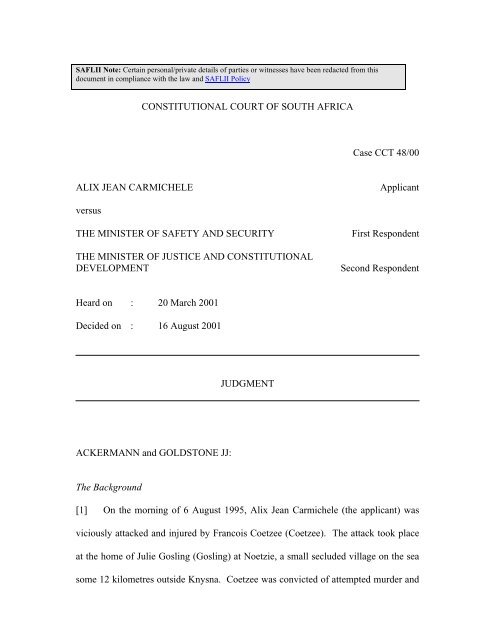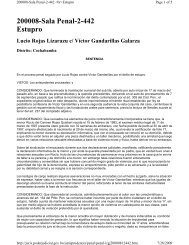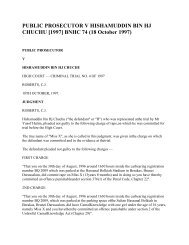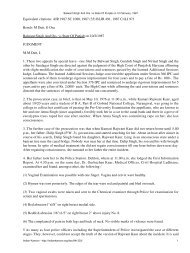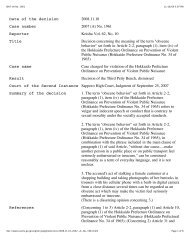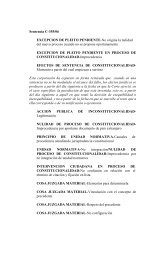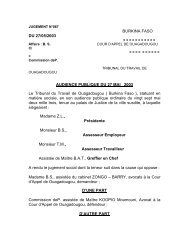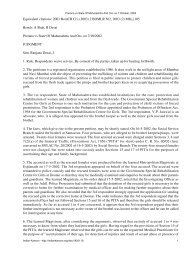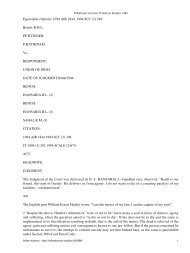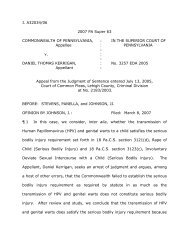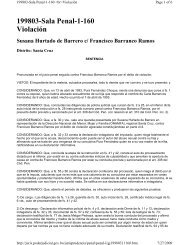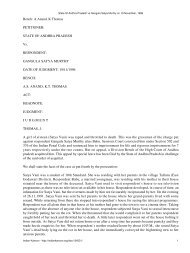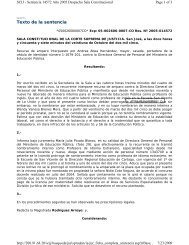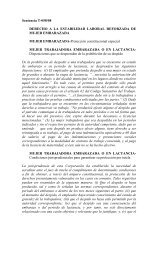CONSTITUTIONAL COURT OF SOUTH AFRICA Case CCT ... - saflii
CONSTITUTIONAL COURT OF SOUTH AFRICA Case CCT ... - saflii
CONSTITUTIONAL COURT OF SOUTH AFRICA Case CCT ... - saflii
You also want an ePaper? Increase the reach of your titles
YUMPU automatically turns print PDFs into web optimized ePapers that Google loves.
ACKERMANN AND GOLDSTONE JJappeal. The jurisdiction of this Court to entertain such an application and therequirements for the grant of special leave were considered in S v Boesak. 2It waspointed out by Langa DP, with reference to section 167(3)(b) of the Constitution, thatthe issues to be decided must be constitutional matters or issues connected withdecisions on constitutional matters. 3It must in addition be in the interests of justicethat the appeal should be heard and in that regard the prospects of success constitutean important factor. 4The Deputy President stated, inter alia, that:“Under s 167(7), the interpretation, application and upholding of the Constitution arealso constitutional matters. So, too, under s 39(2), is the question whether theinterpretation of any legislation or the development of the common law promotes thespirit, purport and objects of the Bill of Rights.” 5In this case we are primarily concerned with the development of the common lawdelictual duty to act.The Facts23452001 (1) SA 912 (CC); 2001 (1) BCLR 36 (CC) at paras 10-15.Id at para 11.Id at para 12.Id at para 14. Section 39(2) of the Constitution provides that:“When interpreting any legislation, and when developing the common law orcustomary law, every court, tribunal or forum must promote the spirit, purport andobjects of the Bill of Rights.”The corresponding provision of the Interim Constitution (IC) (Act 200 of 1993), section 35(3),provided:“In the interpretation of any law and the application development of the common lawor customary law, a court, shall have due regard to the spirit, purport and objects ofthis Chapter.”3
ACKERMANN AND GOLDSTONE JJ[5] The facts which emerged from the evidence adduced on behalf of the applicantin the High Court appear from the judgment of Chetty J and from that of Vivier JAwho delivered the unanimous judgment of the SCA. It will make the discussion inthis judgment more comprehensible if the relevant facts are restated.[6] Coetzee was born in 1973. He had problems of a sexual nature from about theage of ten years and had sexually molested his niece when in his early teens. Hismother, Mrs Annie Coetzee, had been sufficiently concerned to seek advice from theirdoctor but had been advised that her son was too young to be given medication.[7] Coetzee passed his matriculation examinations. He sang for some time in achoir that devoted its time to entertaining ill people. He also spent many hours athome reading.[8] On 3 June 1994, when he was 20 years of age, Coetzee committed an indecentact on a 25 year old acquaintance of his, Beverley Claassen. Late at night, while shewas asleep, he climbed through her open bedroom window and lay next to her in herbed. He indecently fondled her until she awoke and gave the alarm. He escapedthrough the window and ran off. On 6 September 1994, he stood trial on charges ofhousebreaking and indecent assault arising from that incident. He pleaded guilty andwas convicted of both charges. On the housebreaking charge, he was sentenced to 184
ACKERMANN AND GOLDSTONE JJmonths imprisonment conditionally suspended for four years, and on the indecentassault charge he was sentenced to a fine of R600 or six months imprisonment plustwelve months imprisonment conditionally suspended for four years.[9] Less than six months later, on 4 March 1995, Coetzee attempted to rape andmurder E T (E). 6Coetzee and E were school friends. She was then 17 years old.After a dance at the Hornlee Hotel, Knysna, Coetzee offered to walk E home. Sheaccepted his offer. Along the way he persuaded her to take a detour along a footpath.At a deserted spot he attempted to kiss her and, when she resisted, he threw her to theground and repeatedly punched and kicked her. He dragged her into tall grass andripped off her clothes. He forcibly held her down by sitting on her while herepeatedly punched her in the face, throttled her and bit her. He threatened to kill her.She eventually lost consciousness. At his subsequent trial, Coetzee admitted he hadwanted to rape E but denied that he had done so. Whether in fact he did rape E aftershe lost consciousness was not established. He left her for dead and ran back to theHornlee Hotel.[10] When Coetzee arrived at the Hornlee Hotel, he informed the management thathe had just killed a girl and asked them to summon the police. When the policearrived he repeated that he had killed a girl but refused to furnish any further details.6E T is referred to by her first name to avoid confusion with her mother to whom reference is made laterin this judgment.5
He was arrested for being drunk in a public place.ACKERMANN AND GOLDSTONE JJ[11] E regained consciousness, gathered her clothes and walked to the house of aneighbour and friend. She arrived there at about 4 am. She reported the attack to herfriend and shortly thereafter to her own mother (Mrs T) who summoned the police. Ewas taken to hospital where the examining doctor noted the extensive injuries inflictedon her.[12] During that morning (4 March 1995) Mrs T and E went to the Knysna chargeoffice where they reported the attack to the duty officer, Sergeant Beaulah Jantjies(Jantjies). She took a detailed statement from E and Mrs T who informed her thatCoetzee had told them he had a previous conviction for rape. For the benefit of theinvestigating officer, Jantjies noted that information in the investigation diary.Immediately thereafter, the investigating officer, Detective Sergeant David Klein(Klein), took over the matter. He also interviewed E and accompanied her to thescene of the attack where he found a sandal and an item of underwear that E told himbelonged to her.[13] The following morning (5 March 1995), Klein interviewed Coetzee, informinghim of the charge. He appeared in court the next day. In his note to the prosecutor,Klein stated that there was no reason to deny Coetzee bail and recommended that he6
ACKERMANN AND GOLDSTONE JJbe released on warning. Coetzee appeared before Magistrate Von Bratt (theMagistrate) on a charge of rape. The prosecutor, Mr G Olivier (Olivier), did not placebefore the magistrate any information concerning Coetzee’s previous conviction, nordid he oppose Coetzee’s release on his own recognisance.Coetzee wasunconditionally released and warned to appear again on 17 March 1995.[14] After his release, Coetzee returned to Noetzie where he was living with hismother. A day or two later, Mrs T called on Gosling, who is a friend of the applicant.Mrs Coetzee worked for Gosling both as a domestic worker and as a general assistantin her business in Knysna. The purpose of Mrs T’s visit was to inform Gosling of theattack on E and of Coetzee’s previous conviction. In evidence in the High Court,Gosling stated that she was distressed at the news because she thought:“that he would obviously commit this crime again and I felt very scared to beanywhere where he was.”She added that she felt:“that he shouldn’t maintain a presence in society because my knowledge as a nursingsister and just in life is that a man that has committed two similar crimes is going todo it again.”[15] Because of her concern, Gosling went to speak to Captain Lawrence Oliver(Oliver), a police officer at the Knysna police station. She told him she did not think7
ACKERMANN AND GOLDSTONE JJthat Coetzee “should be out on the street” and asked whether he could not be detainedpending his trial. Oliver advised her to discuss the matter with the senior prosecutorat Knysna, Ms Dian Louw (Louw). Gosling went to Louw whom she knew well. Heroffice was in the same building as the Knysna police station. She told Louw that she:“was afraid that Francois would hurt one of my friends or me and that I really thoughthe would commit this crime again.”Louw informed her that there was no law to protect them and that the authorities’hands were tied unless Coetzee committed another offence.[16] On 10 March 1995, Coetzee called at the T home and told Mrs T that hewanted to talk. She ordered him off the premises and summoned the police. Coetzeeran away. When the police arrived, she reported the incident. She was upset that hewas at large.[17] On 13 March 1995, Mrs Coetzee’s relative, Detective Sergeant Grootboom(Grootboom) gave her a lift home. He was also stationed at the Knysna police station.She informed him that she was concerned about Coetzee, who was withdrawn, andshe feared he might attempt suicide or “get up to something.” She raised theseconcerns with Grootboom in the hope that he might arrange for her son to be sent tosome institution where he could be treated. When they arrived at her home they foundthat Coetzee had indeed attempted suicide. Grootboom took him to hospital where he8
ARTICLE IN PRESSR.C. Batra et al. / Engineering Analysis with Boundary Elements 30 (2006) 949–962 957Table 2For the circular MEMS, comparison of the MLPG results with those fromthe method of Section 5.2.1x 2Method of Section 5.2.1MLPGl PI ku PI k 1 l PI ku PI k 10.7890 0.4365 0.7915 0.44331λ = 0.485u(x 1 ,x 2 )0-0.20-0.4-0.6-0.800.25x 20.50.250.75x 10.50.75Fig. 8. Deformed shape of a quarter of the circular MEMS for l ¼ 0:485.domain. We compare our results with those obtained in[12] by the finite-difference method using 1600 points.In the MLPG implementation, we use the 165 nodeslocated as shown in Fig. 9. Values of weight functionsparameters are the same as those for the circular diskproblem studied in Section 5.2.Fig. 10 exhibits the infinity norm of the deflection versusthe load parameter l. Numerical solutions from the MLPGand the finite-difference methods are compared in Table 3.The symmetry breaking voltage, l SB , is less than the pull-involtage l PI , and the maximum difference between thecorresponding values of l PI , ku PI k 1 and l SB is 1:53%.Figs. 11a and b report the symmetric, and theasymmetric deformed shapes of the annular disk after thepull-in, for l ¼ 1:34, and 1:18, respectively.Fig. 12 depicts the variation of the pull-in parameters,l PI and ku PI k 1 , with the ratio (inner radius)/(outer radius),1keeping the outer radius at the constant value 1. TheMLPG results are computed using 165 nodes. Thenondimensional pull-in voltage data are fitted with aquadratic polynomial (dashed line), and the correspondingnondimensional pull-in maximum deflections with a polynomialof degree zero (solid line). Expressions for theaforementioned polynomials arel PI ¼ 1:33 þ 16:3 r 2 ; ku PI k 1 ¼ 0:390,where r is the ratio (inner radius)/(outer radius). Whereasthe maximum pull-in deflection is nearly independent of theratio of the inner to the outer radius of the MEMS, thepull-in voltage increases essentially quadratically with thisratio. Fig. 13 exhibits the dependence of symmetry breakingparameters, l SB and ku SB k 1 , upon the ratio of the innerto the outer radius of the annular disk. With increasinginner radii, the nondimensional pull-in voltage l PI significantlyincreases due to increased stiffness of the system,and the same holds for the nondimensional lowestsymmetry breaking voltage, l SB . Whereas the nondimensionalpull-in maximum deflection, ku PI k 1 , is virtuallyindependent of the inner radius of the disk, the nondimensionalsymmetry breaking maximum deflection, ku SB k 1 ,decreases with increasing inner radius. Expressions for thebest fit polynomials in Fig. 13 arel SB ¼ 1:27 þ 16:6r 2 ; ku SB k 1 ¼ 0:513 0:254r.Fig. 14 shows the variation with the ratio r, of thequantity ðr rÞ=ð1 rÞ, where r is the ratio between theradial location of the nondimensional pull-in maximumdisplacement ku PI k 1 , and the outer radius of the ring.MLPG data are fitted with a quadratic polynomial (solidline) whose expression isr1 r ¼ 0:343 þ 0:450r 0:423r2 .r 5.4. Elliptic disk0.1Fig. 9. Locations of 165 nodes on one-half of an annular disk.We consider an ellipse of semi-major axis a ¼ 1, semiminoraxis b, and clamped along its periphery. We analyze1x 1
ACKERMANN AND GOLDSTONE JJascertain whether an accused person is by reason of mental illness or mental defectincapable of understanding trial proceedings so as to make a proper defence. On thesame day Louw prepared a report for the hospital authorities in which she included thedetails of the attack on E, a reference to his previous conviction, a description of theevents thereafter and a rendition of her interview with Coetzee.[20] On 18 April 1995, on his return from Valkenberg Hospital, Coetzee againappeared in the Knysna magistrate’s court. The prosecutor was again Olivier and thepresiding magistrate a Mr Goosen. According to the report from Valkenberg HospitalCoetzee was found to be mentally capable of understanding the proceedings and ableto make a proper defence, and was also found to have been mentally capable at thetime of his attack on E. 8The criminal charges were put to Coetzee and he pleaded notguilty. He gave as his reason his doubt as to whether he had raped the complainant.The case was postponed to 2 May 1995 pending the attorney-general’s decisionwhether to proceed in the High Court. There is no reference in the record to thequestion of bail having been raised. Coetzee was warned to appear on 2 May 1995.On that date the trial was further postponed.[21] The applicant frequently stayed at Gosling’s home in Noetzie. On one such8Although the referral was only in terms of section 77(1) of the Criminal Procedure Act, which relatesto whether the accused is capable of understanding the proceedings in question so as to make a proper defence,it appears from the record that Valkenberg treated the enquiry as also having been made under section 78(2),which relates to whether the accused “is by reason of mental illness or mental defect not criminally responsiblefor the offence charged.”10
ACKERMANN AND GOLDSTONE JJoccasion towards the end of June 1995, Gosling left for work in the morning. Shortlyafter she had left, the applicant noticed Coetzee snooping around the house, looking inat a window and trying to open it. The applicant called to him and asked what he wasdoing there. He replied that he was looking for Gosling. He then left. The applicanttelephoned Gosling and reported the incident. Gosling informed the applicant thatCoetzee’s excuse was false as he must have seen her driving away in her motorvehicle.[22] At the request of the applicant, Gosling again went to the Knysna police stationand reported the incident to Captain Oliver who again referred her to Louw.According to Gosling’s evidence“I said Dian you’ve got to do something about this guy, there must be some law toprotect society, not necessarily me or people at Noetzie and she said to me that therewas nothing she could do.”On 2 August 1995 both the applicant and Gosling again broached the matter withLouw when she visited them at Gosling’s business premises. Again, according toGosling, Louw claimed she was powerless to do anything about Coetzee.[23] On Sunday, 6 August 1995 the applicant went to Gosling’s home where theyhad arranged to meet. Gosling had not yet arrived. The applicant went into the houseand was confronted by Coetzee who had apparently broken in. He immediately11
ACKERMANN AND GOLDSTONE JJattacked her with a pick handle. His blows were directed at her head and face. Whenshe lifted her arm to protect herself, one of the blows struck and broke her arm. Hethreatened her and dragged her around the house. He repeatedly ordered her to turnaround. She refused to do so. He discarded the pick handle and lunged at her with aknife. He stabbed her left breast and the blade of the knife buckled as it hit herbreastbone. He lunged at her again and she kicked him. He lost his balance and shemanaged to escape through a door. She ran along the beach where someone came toher assistance. Coetzee was charged on a number of counts including one ofattempting to murder the applicant.[24] The prosecution of Coetzee on the charge of raping E came to trial on 11September 1995. He admitted that he had assaulted her but denied rape. He wasconvicted of attempted rape and sentenced to seven years imprisonment. On 13December 1995 he was prosecuted for the attack on the applicant and was convictedof attempted murder and of housebreaking. As mentioned above, he was given aneffective sentence of twelve-and-a-half years imprisonment.The Applicant’s Cause of Action[25] The applicant’s claim is founded in delict. The direct cause of the damages shesuffered was the assault by Coetzee. However, the applicant wishes to hold therespondents liable because of the alleged wrongful acts or omissions of the police12
ACKERMANN AND GOLDSTONE JJofficer (Klein) or the prosecutors (Louw and Olivier) at times when they were actingin the course and scope of their employment with the State. In order to succeed, theapplicant would have to establish at the trial that:(a)Klein or the prosecutors respectively owed a legal duty to the applicantto protect her;(b)Klein or the prosecutors respectively acted in breach of such a duty anddid so negligently;(c)there was a causal connection between such negligent breach of the dutyand the damage suffered by the applicant.In deciding whether to grant the respondents’ application for absolution from theinstance the trial court and the SCA dealt with issue (a) only. Having found againstthe applicant in respect of that issue, it became unnecessary to consider whether therewas sufficient evidence on the remaining two issues to place the respondents on theirdefence.The Test for an Order of Absolution from the Instance[26] Both the trial judge and SCA applied the appropriate test for the grant ofabsolution from the instance at the close of the plaintiff’s case, viz. whether a court,applying its mind reasonably to the evidence, could or might (not should or ought to)find that the police or prosecutors at Knysna owed a legal duty to the applicant to13
ACKERMANN AND GOLDSTONE JJprotect her. 9The Argument in this Court in Relation to the Duty to Act[27] In her particulars of claim the applicant contended that the relevant members ofthe South African Police Services and the prosecutors owed her a duty to:“. . . ensure that she enjoyed her constitutional rights of inter alia the right to life, theright to respect for and protection of her dignity, the right to freedom and security, theright to personal privacy and the right to freedom of movement.”[28] Counsel for the applicant submitted that both the High Court and the SCAerred in not applying the relevant provisions of the Constitution in determiningwhether Klein or the prosecutors owed a legal duty to the applicant to protect her. Inparticular, counsel relied upon the constitutional obligation on all courts to “developthe common law” with due regard to the “spirit, purport and objects” of the Bill ofRights. He submitted that, had the common law been so developed, the High Courtand the SCA would have found that there existed a legal duty to act.[29] It was further contended for the applicant that the common law duty to actshould be developed in the light of the provisions of the Bill of Rights in the interimConstitution (IC) which was in operation at all times relevant to the applicant’s causeof action. Counsel relied on the following provisions of the IC:9Gordon Lloyd Page & Associates v Rivera and Another 2001 (1) SA 88 (SCA) at 92E-93A.14
ACKERMANN AND GOLDSTONE JJ“8. Equality.—(1) Every person shall have the right to equality before the law and toequal protection of the law.(2) No person shall be unfairly discriminated against, directly or indirectly, andwithout derogating from the generality of this provision, on one or more of thefollowing grounds in particular: race, gender, sex, ethnic or social origin, colour,sexual orientation, age, disability, religion, conscience, belief, culture or language.(3) (a) This section shall not preclude measures designed to achieve the adequateprotection and advancement of persons or groups or categories of personsdisadvantaged by unfair discrimination, in order to enable their full and equalenjoyment of all rights and freedoms.(b) Every person or community dispossessed of rights in land before thecommencement of this Constitution under any law which would have beeninconsistent with subsection (2) had that subsection been in operation at the time ofthe dispossession, shall be entitled to claim restitution of such rights subject to and inaccordance with sections 121, 122 and 123.(4) Prima facie proof of discrimination on any of the grounds specified in subsection(2) shall be presumed to be sufficient proof of unfair discrimination as contemplatedin that subsection, until the contrary is established.9. Life.—Every person shall have the right to life.10. Human dignity.—Every person shall have the right to respect for and protectionof his or her dignity.11. Freedom and security of the person.—(1) Every person shall have the right tofreedom and security of the person, which shall include the right not to be detainedwithout trial.(2) No person shall be subject to torture of any kind, whether physical, mental oremotional, nor shall any person be subject to cruel, inhuman or degrading treatment orpunishment.. . . .15
ACKERMANN AND GOLDSTONE JJ13. Privacy.—Every person shall have the right to his or her personal privacy, which shallinclude the right not to be subject to searches of his or her person, home or property, theseizure of private possessions or the violation of private communications.”Counsel relied further on the provisions of section 215 of the IC, which read:“The powers and functions of the Service shall be–(a) the prevention of crime;(b) the investigation of any offence or alleged offence;(c) the maintenance of law and order; and(d) the preservation of the internal security of the Republic.”More specifically, so the submission ran, the IC imposed a particular duty on the stateto protect women against violent crime in general and sexual abuse in particular. TheCourt was referred to the following statement of the SCA in S v Chapman: 10“Rape is a very serious offence, constituting as it does a humiliating, degrading andbrutal invasion of the privacy, the dignity and the person of the victim.The rights to dignity, to privacy and the integrity of every person are basic to theethos of the Constitution [in a footnote there is reference, inter alia, to sections 10, 11and 13 of the IC] and to any defensible civilisation.Women in this country are entitled to the protection of these rights.”[30] It was submitted further that the police and prosecution services are among theprimary agencies of the state responsible for the discharge of its constitutional duty toprotect the public in general and women in particular against violent crime. It wasconceded by counsel for the applicant that it does not follow that any such failure in101997 (3) SA 341 (A) at 344J-45B, per Mohamed CJ, and Van Heerden and Olivier JJA.16
ACKERMANN AND GOLDSTONE JJthat duty entitles the victim to damages in delict. It was contended, however, that onthe facts of this case, the applicant is entitled to such damages.[31] Despite the failure by the applicant to rely directly upon the provisions of eithersection 35(3) of the IC or section 39(2) of the Constitution in the High Court andSCA, counsel for the respondent did not object to this issue being raised in this Court.If covered by the pleadings, and in the absence of unfairness, parties are ordinarily notprecluded from raising new legal arguments on appeal. 11In constitutional matters,however, courts have an interest in a constitutional issue being raised timeously. Therelevance of this omission in the present case is dealt with later in this judgment. 12[32] Neither the trial court nor the SCA had regard to these provisions of the Bill ofRights in the IC or the Constitution. They also did not to have regard to section 39(2)of the Constitution, which requires all our courts to develop the common law with dueregard to the “spirit, purport and objects” of the Bill of Rights. 13The Obligation to Develop the Common Law[33] The Constitution is the supreme law. The Bill of Rights, under the IC, applied11Cole v Government of the Union of S.A. 1910 AD 263 at 272-73; Paddock Motors (Pty) Ltd v Igesund1976 (3) SA 16 (A) at 23B-24G.1213See paras 41, 50 et seq and 78 et seq.Above n 5.17
ACKERMANN AND GOLDSTONE JJto all law. 14Item 2 of schedule 6 to the Constitution provides that “all law” that wasin force when the Constitution took effect, “continues in force subject to . .consistency with the Constitution.” 15Section 173 of the Constitution gives to allhigher courts, including this Court, the inherent power to develop the common law,taking into account the interests of justice. 16In section 7 of the Constitution, the Billof Rights enshrines the rights of all people in South Africa, and obliges the state torespect, promote and fulfil these rights. Section 8(1) of the Constitution makes theBill of Rights binding on the judiciary as well as on the legislature and executive.Section 39(2) of the Constitution provides that when developing the common law,every court must promote the spirit, purport and objects of the Bill of Rights. 17Itfollows implicitly that where the common law deviates from the spirit, purport andobjects of the Bill of Rights the courts have an obligation to develop it by removingthat deviation.14Section 7(2) of the IC provided that:“This Chapter shall apply to all law in force . . . during the period of the operation ofthis Constitution.”15Since the Bill of Rights applies to all law, and there is no material difference between section 35(3) ofthe IC and section 39(2) of the Constitution, it is unnecessary to consider in this case whether the principle ofnon-retrospectivity applies. See Du Plessis and Others v De Klerk and Another 1996 (3) SA 850 (CC); 1996(5) BCLR 658 (CC) at paras 15-24.16Section 173 provides:“The Constitutional Court, Supreme Court of Appeal and High Courts have theinherent power to protect and regulate their own process, and to develop the commonlaw, taking into account the interests of justice.”17As emerges from the provisions of section 35(3) of the IC and section 39(2) of the Constitution, thedevelopment of the common law will not be different whether we “have regard to” or “promote” the “spirit,purport and objects” of the respective Bills of Rights.18
ACKERMANN AND GOLDSTONE JJ[34] Under the IC the circumstances in which the common law could be developedby this Court was a complex issue. 18However, under the Constitution there can be noquestion that the obligation to develop the common law with due regard to the spirit,purport and objects of the Bill of Rights is an obligation which falls on all of ourcourts including this Court.[35] In this case the High Court and the SCA were requested to develop thecommon law, not on a constitutional basis, but in the light of the unusual nature of theapplicant’s cause of action. The common law, especially in the field of delictualliability, has constantly required development. 19Where a court develops the commonlaw, the provisions of section 39(2) of the Constitution oblige it to have regard to thespirit, purport and objects of the Bill of Rights.[36] In exercising their powers to develop the common law, judges should bemindful of the fact that the major engine for law reform should be the legislature andnot the judiciary. In this regard it is worth repeating the dictum of Iacobucci J in R vSalituro, 20 which was cited by Kentridge AJ in Du Plessis v De Klerk: 2118Du Plessis v De Klerk, above n 15 at paras 65-66; Gardener v Whitaker 1996 (4) SA 337; 1996 (6)BCLR 775 (CC) at paras 16-18.19See Minister van Polisie v Ewels 1975 (3) SA 590 (A) at 596G-97H. See also Administrateur, Natal vTrust Bank van Afrika Bpk 1979 (3) SA 824 (A) at 828H-29B; Marais v Richard En ‘n Ander 1981 (1) SA 1157(A) at 1166H-67A; Pakendorf En Andere v De Flamingh 1982 (3) SA 146 (A) at 157E-58G; and Schultz v Butt1986 (3) SA 667 (A) at 681D-83I.20(1992) 8 CRR (2d) 173.19
ACKERMANN AND GOLDSTONE JJ“Judges can and should adapt the common law to reflect the changing social, moraland economic fabric of the country. Judges should not be quick to perpetuate ruleswhose social foundation has long since disappeared. Nonetheless there are significantconstraints on the power of the judiciary to change the law. . . . In a constitutionaldemocracy such as ours it is the Legislature and not the courts which has the majorresponsibility for law reform . . . . The judiciary should confine itself to thoseincremental changes which are necessary to keep the common law in step with thedynamic and evolving fabric of our society.”Under our Constitution the duty cast upon judges is different in degree to that whichthe Canadian Charter of Rights cast upon Canadian judges. In South Africa, the ICbrought into operation, in one fell swoop, a completely new and different set of legalnorms. 22In these circumstances the courts must remain vigilant and should nothesitate to ensure that the common law is developed to reflect the spirit, purport andobjects of the Bill of Rights. We would add, too, that this duty upon judges arises inrespect both of the civil and criminal law, whether or not the parties in any particularcase request the court to develop the common law under section 39(2).[37] The proceedings in the High Court and the SCA took place after 4 February1997 when the Constitution became operative. It follows that both the High Courtand the SCA were obliged to have regard to the provisions of section 39(2) of the21Above n 15 at para 61.22See S v Makwanyane and Another 1995 (3) SA 391 (CC); 1995 (6) BCLR 665 (CC) at para 262 perMahomed J.20
ACKERMANN AND GOLDSTONE JJConstitution when developing the common law. 23However, both courts assumed thatthe pre-constitutional test for determining the wrongfulness of omissions in delictualactions of this kind should be applied. In our respectful opinion, they overlooked thedemands of section 39(2).[38] In the High Court and the SCA the applicant relied only on the common lawunderstanding of wrongfulness which has been developed by our courts over manyyears. Save in one respect referred to in the applicant’s heads of argument in theSCA, no reliance was placed on the provisions of the IC or the Constitution as havingin any way affected the common law duty to act owed by police officers orprosecutors to members of the public. With regard to the “interests of thecommunity” imposing a legal liability on the authorities, it was submitted by theapplicant’s counsel that it would “encourage the police and prosecuting authorities toact positively to prevent violent attacks on women.” In support of that submissioncounsel referred to authorities in this Court and the SCA devoted to patterns ofdiscrimination against women. 24It does not appear to have been suggested that therewas any obligation on the High Court or the SCA to develop the common law ofdelict in terms of section 39(2) of the Constitution. 2523Amod v Multilateral Motor Vehicle Accidents Fund 1998 (4) SA 753 (CC); 1998 (10) BCLR 1207(CC) at para 22.24Brink v Kitshoff NO 1996 (4) SA 197 (CC); 1996 (6) BCLR 752 (CC); S v Baloyi (Minister of Justiceand Another Intervening) 2000 (2) SA 425 (CC); 2000 (1) BCLR 86 (CC); S v Chapman, above n 10.25Above n 5.21
ACKERMANN AND GOLDSTONE JJ[39] It needs to be stressed that the obligation of courts to develop the common law,in the context of the section 39(2) objectives, is not purely discretionary. On thecontrary, it is implicit in section 39(2) read with section 173 that where the commonlaw as it stands is deficient in promoting the section 39(2) objectives, the courts areunder a general obligation to develop it appropriately. We say a “general obligation”because we do not mean to suggest that a court must, in each and every case where thecommon law is involved, embark on an independent exercise as to whether thecommon law is in need of development and, if so, how it is to be developed undersection 39(2). At the same time there might be circumstances where a court is obligedto raise the matter on its own and require full argument from the parties.[40] It was implicit in the applicant’s case that the common law had to be developedbeyond existing precedent. In such a situation there are two stages to the inquiry acourt is obliged to undertake. They cannot be hermetically separated from oneanother. The first stage is to consider whether the existing common law, havingregard to the section 39(2) objectives, requires development in accordance with theseobjectives. This inquiry requires a reconsideration of the common law in the light ofsection 39(2). If this inquiry leads to a positive answer, the second stage concernsitself with how such development is to take place in order to meet the section 39(2)objectives. Possibly because of the way the case was argued before them, neither the22
ACKERMANN AND GOLDSTONE JJHigh Court nor the SCA embarked on either stage of the above inquiry.[41] There is an obligation on litigants to raise constitutional arguments in litigationat the earliest reasonable opportunity in order to ensure that our jurisprudence underthe Constitution develops as reliably and harmoniously as possible. In the result thisCourt has not had the benefit of any assistance from either court on either stage of theinquiry referred to above. We consider later what this Court should do in thesecircumstances. But first it is necessary to deal with the reasons of the SCA fordismissing the appeal.[42] The SCA, as the High Court had done, had regard and referred to wrongfulnessas it has been developed in our common law prior to the operation of the IC. VivierJA stated the following in his judgment:“The appropriate test for determining the wrongfulness of omissions in delictualactions for damages in our law has been settled in a number of decisions of this Courtsuch as Minister van Polisie v Ewels 1975 (3) SA 590 (A) at 597A–C; Minister ofLaw and Order v Kadir 1995 (1) SA 303 (A) at 317C–318I; Knop v JohannesburgCity Council 1995 (2) SA 1 (A) at 27G–I and Government of the Republic of SouthAfrica v Basdeo and Another 1996 (1) 355 (A) at 367E–H. The existence of the legalduty to avoid or prevent loss is a conclusion of law depending upon a consideration ofall the circumstances of each particular case and on the interplay of many factorswhich have to be considered. The issue, in essence, is one of reasonableness,determined with reference to the legal perceptions of the community as assessed bythe Court.In Minister of Law and Order v Kadir (supra) Hefer JA stated the nature of the23
ACKERMANN AND GOLDSTONE JJenquiry thus at 318E–H:‘As the judgments in the cases referred to earlier demonstrate, conclusions asto the existence of a legal duty in cases for which there is no precedent entailpolicy decisions and value judgments which “shape and, at times, refashionthe common law [and] must reflect the wishes, often unspoken, and theperceptions, often dimly discerned, of the people” (per M M Corbett in alecture reported sub nom “Aspects of the Role of Policy in the Evolution ofthe Common Law” in (1987) SALJ 52 at 67). What is in effect required isthat, not merely the interests of the parties inter se, but also the conflictinginterests of the community, be carefully weighed and that a balance be struckin accordance with what the court conceives to be society’s notions of whatjustice demands.’Hefer JA also stressed the difference between morally reprehensible and legallyactionable omissions and warned that a legal duty is not determined by the mererecognition of social attitudes and public and legal policy (at 320A–B). The questionmust always be whether the defendant ought reasonably and practically to haveprevented harm to the plaintiff: in other words, is it reasonable to expect of thedefendant to have taken positive measures to prevent the harm (Prof J C van der Waltin Joubert (ed) The Law of South Africa vol 8 1 st re-issue part 1 para 56).” 26[43][ As pointed out in the quotation above, in determining whether there was a legalduty on the police officers to act, Hefer JA in Minister of Law and Order v Kadir 27referred to weighing and the striking of a balance between the interests of parties andthe conflicting interests of the community. This is a proportionality exercise withliability depending upon the interplay of various factors. Proportionality is consistentwith the Bill of Rights, but that exercise must now be carried out in accordance with2627Above n 1 at para 7.1995 (1) SA 303 (A) at 318E-H.24
ACKERMANN AND GOLDSTONE JJthe “spirit, purport and objects of the Bill of Rights” and the relevant factors must beweighed in the context of a constitutional state founded on dignity, equality andfreedom and in which government has positive duties to promote and uphold suchvalues.[44] Under both the IC and the Constitution, the Bill of Rights entrenches the rightsto life, 28 human dignity 29 and freedom and security of the person. 30The Bill of Rightsbinds the state and all of its organs. Section 7(1) of the IC provided:“This Chapter shall bind all legislative and executive organs of state at all levels ofgovernment.”Section 8(1) of the Constitution provides:“The Bill of Rights applies to all law, and binds the legislature, the executive, thejudiciary and all organs of state.”It follows that there is a duty imposed on the state and all of its organs not to performany act that infringes these rights. In some circumstances there would also be apositive component which obliges the state and its organs to provide appropriateprotection to everyone through laws and structures designed to afford such protection.282930Section 9 of the IC; Section 11of the Constitution.Section 10 of the IC and the Constitution.Section 11 of the IC; Section 12 of the Constitution.25
ACKERMANN AND GOLDSTONE JJ[45] In the United States, a distinction is drawn between “action” and “inaction” inrelation to the “due process” clause of their Constitution, (the 14 th Amendment). InDeShaney v Winnebago County Department of Social Services, 31the majoritydeclined to hold a government authority liable for a failure to take positive action toprevent harm. As stated in the dissent of Brennan J:“The Court’s baseline is the absence of positive rights in the Constitution and aconcomitant suspicion of any claim that seems to depend on such rights.” 32The provisions of our Constitution, however, point in the opposite direction. So toodo the provisions of the European Convention on Human Rights (Convention).Article 2(1) of the Convention provides that “Everyone’s right to life shall beprotected by law.” This corresponds with our Constitution’s entrenchment of the rightto life. We would adopt the following statement in Osman v United Kingdom: 33“It is common ground that the State’s obligation in this respect extends beyond itsprimary duty to secure the right to life by putting in place effective criminal lawprovisions to deter the commission of offences against the person backed up by lawenforcementmachinery for the prevention, suppression and sanctioning of breaches ofsuch provisions. It is thus accepted by those appearing before the Court that Article 2of the Convention may also imply in certain well-defined circumstances a positiveobligation on the authorities to take preventive operational measures to protect anindividual whose life is at risk from the criminal acts of another individual.”313233489 US 189 (1988).Id at 204.29 EHHR 245 at 305, para 115.26
ACKERMANN AND GOLDSTONE JJ[46] Counsel for the respondents referred us to decisions of the English courts inwhich public authorities such as the police and local authorities have been grantedwhat amounts to an immunity against claims in delict by members of the public. 34However, in a recent decision of the House of Lords a more flexible approach todelictual claims against public authorities has emerged. In Barrett v Enfield LondonBorough Council 35 the decision to strike out a claim against a local authority for thenegligent failure to safeguard the welfare of a minor was reversed. The reasoning ofLord Browne-Wilkinson is as follows:“(1) Although the word ‘immunity’ is sometimes incorrectly used, a holding that it isnot fair, just and reasonable to hold liable a particular class of defendants whethergenerally or in relation to a particular type of activity is not to give immunity from aliability to which the rest of the world is subject. It is a prerequisite to there being anyliability in negligence at all that as a matter of policy it is fair, just and reasonable inthose circumstances to impose liability in negligence. (2) In a wide range of casespublic policy has led to the decision that the imposition of liability would not be fairand reasonable in the circumstances, eg some activities of financial regulators,building inspectors, ship surveyors, social workers dealing with sex abuse cases. Inall these cases and many others the view has been taken that the proper performance34In the case of Hill v Chief Constable of West Yorkshire [1989] 1 AC 53 (HL) the House of Lords foundit necessary to protect the police from delictual claims on the view that the interests of the community as awhole are best served by a police force that is not diverted and prejudiced by being diverted from its primaryduties by the exposure to such liability.“The result would be a significant diversion of police manpower and attention fromtheir most important function, that of the suppression of crime.”Per Lord Keith of Kinkel at 63G. Similar considerations led the House of Lords to deny claims againstlocal authorities for negligence in respect of the discharge of their functions concerning the welfare ofchildren in X and Others v Bedfordshire County Council [1995] 2 AC 633 (HL) per Staughton LJ at674H-75G, and per Peter Gibson LJ at 681G-H.35[1999] 3 All ER 193.27
ACKERMANN AND GOLDSTONE JJof the defendant’s primary functions for the benefit of society as a whole will beinhibited if they are required to look over their shoulder to avoid liability innegligence. In English law the decision as to whether it is fair, just and reasonable toimpose a liability in negligence on a particular class of would-be defendants dependson weighing in the balance the total detriment to the public interest in all cases fromholding such class liable in negligence as against the total loss to all would-beplaintiffs if they are not to have a cause of action in respect of the loss they haveindividually suffered. (3) In English law, questions of public policy and the questionwhether it is fair and reasonable to impose liability in negligence are decided asquestions of law. Once the decision is taken that, say, company auditors though liableto shareholders for negligent auditing are not liable to those proposing to invest in thecompany (see Caparo Industries plc v Dickman [1990] 1 All ER 568, [1990] 2 AC605), that decision will apply to all future cases of the same kind. The decision doesnot depend on weighing the balance between the extent of the damage to the plaintiffand the damage to the public in each particular case.” 36[47] In two cases the European Court of Human Rights has found against the“immunity approach” of the English courts. We have already referred to the decisionin Osman. 37There it was stated:“In their alternative submission the applicants asserted that even if it could be saidthat the immunity pursued a legitimate aim or aims, its operation offended against theprinciple of proportionality. They reasoned in this respect that the immunity wascomplete and as such did not distinguish between cases where the merits were strongand those where they were weak. In the instant case, involving the protection of achild and the right to life and where the damage caused was grave, the requirementsof public policy could not dictate that the police should be immune from liability.Furthermore, the combined effect of the strict tests of proximity and foreseeability3637Id at 199d-j.Above n 33.28
ACKERMANN AND GOLDSTONE JJprovided limitation enough to prevent untenable cases ever reaching a hearing and toconfine liability to those cases where the police have caused serious loss through trulynegligent actions.” 38[48] The second case, Z and Others v United Kingdom, 39 was the appeal to theEuropean Court of Human Rights from the decision of the House of Lords in the caseof X and Others v Bedfordshire County Council. 40The European Court held that theimmunity approach effectively precluded the plaintiffs from having“. . . available to them an appropriate means of obtaining a determination of theirallegations that the local authority failed to protect them from inhuman and degradingtreatment and the possibility of obtaining an enforceable award of compensation forthe damages suffered thereby.” 41This was found to contravene the provisions of Article 13 of the Convention, 42 and theCourt consequently made an award of damages to the appellants.[49] Fears expressed about the chilling effect such delictual liability might have onthe proper exercise of duties by public servants are sufficiently met by the3839404142Id at 314, para 142.Application no 29392/95, 10 May 2001, as yet unreported.Above n 34.Id at para 111.Article 13 provides:“Everyone whose rights and freedoms as set forth in this Convention are violatedshall have an effective remedy before a national authority notwithstanding that theviolation has been committed by persons acting in an official capacity.”29
ACKERMANN AND GOLDSTONE JJproportionality exercise which must be carried out and also by the requirements offoreseeability and proximity. This exercise in appropriate cases will establish limits tothe delictual liability of public officials. A public interest immunity excusing therespondents from liability that they might otherwise have in the circumstances of thepresent case, would be inconsistent with our Constitution and its values. Liability inthis case must thus be determined on the basis of the law and its application to thefacts of the case, and not because of an immunity against such claims granted to therespondents.The Development of the Common Law Under Section 39(2)[50] This Court has consistently, and in various contexts, confirmed the importanceof judgments on constitutional issues by the high courts and the Supreme Court ofAppeal in cases to be considered by this Court. This is a weighty consideration, forexample, when considering whether to grant direct access 43 or to allow an appealdirectly to this Court. 44In Bequinot’s case 45 the following was said on behalf of a43See, for example, Transvaal Agricultural Union v Minister of Land Affairs and Another 1997 (2) SA621 (CC); 1996 (12) BCLR 1573 (CC) at para 18; S v Bequinot 1997 (2) SA 887 (CC); 1996 (12) BCLR 1588(CC) at para 15; Bruce and Another v Fleecytex Johannesburg CC and Others 1998 (2) SA 1143 (CC); 1998(4) BCLR 415 (CC) at para 8; Christian Education South Africa v Minister of Education 1999 (2) SA 83 (CC);1998 (12) BCLR 1449 (CC) at paras 8 and 12; and Dormehl v Minister of Justice and Others 2000 (2) SA 987(CC); 2000 (5) BCLR 471 (CC) at para 5.44See, for example, Amod v Multilateral Motor Vehicle Accidents Fund, above n 23 at para 33; Memberof the Executive Council for Development Planning and Local Government, Gauteng v Democratic Party andOthers 1998 (4) SA 1157 (CC); 1998 (7) BCLR 855 (CC) at paras 31-32; and De Freitas and Another v Societyof Advocates of Natal (Natal Law Society Intervening) 1998 (11) BCLR 1345 (CC) at paras 20-21.45Above n 43.30
ACKERMANN AND GOLDSTONE JJunanimous Court:“. . . this Court would have . . . to decide the issue without the benefit of the wisdomof the Court below. It has been said before but needs to be restated that this Court isplaced at a grave disadvantage if it is required to deal with difficult questions of law,constitutional or otherwise, and has to perform the balancing exercise demanded by s33(1) of the Constitution virtually as a court of first instance.” 46 (emphasis supplied).[51][ There are other public and judicial policy considerations, such as fairness to thelosing litigant, which underpin such an approach as was recognised in Bruce vFleecytex 47 where the following was stated by this Court:“It is, moreover, not ordinarily in the interests of justice for a court to sit as a court offirst and last instance, in which matters are decided without there being anypossibility of appealing against the decision given. Experience shows that decisionsare more likely to be correct if more than one court has been required to consider theissues raised. In such circumstances the losing party has an opportunity ofchallenging the reasoning on which the first judgment is based, and of reconsideringand refining arguments previously raised in the light of such judgment.” 48[52] In Christian Education South Africa v Minister of Education 49 Langa DP,writing for another unanimous Court, dismissed as having “no merit” an argumentthat the aforementioned principle was less significant where the issue involved a value46474849Id at para 15 citation omitted.Above n 43.Id at para 8.Above n 43.31
ACKERMANN AND GOLDSTONE JJjudgment and therefore assumed less importance for the interests of justice. He statedthat:“. . . the exclusion of the other courts from the exercise of a jurisdiction given to themby the Constitution would clearly not be in the general interests of justice and thedevelopment of our jurisprudence.” 50[53] The above principles become singularly compelling when the issue is whetheror how the common law is to be developed under section 39(2) of the Constitution,particularly when this Court has not previously been required to do so. As this Courtstated in Amod’s case: 51“When a constitutional matter is one which turns on the direct application of theConstitution and which does not involve the development of the common law,considerations of costs and time may make it desirable that the appeal be broughtdirectly to this Court. But when the constitutional matter involves the development ofthe common law, the position is different. The Supreme Court of Appeal hasjurisdiction to develop the common law in all matters including constitutional matters.Because of the breadth of its jurisdiction and its expertise in the common law, itsviews as to whether the common law should or should not be developed in a‘constitutional matter’ are of particular importance.”This passage was quoted with approval in the De Freitas case. 52505152Id at para 9.Above n 44 at para 33.Above n 44 at para 21.32
ACKERMANN AND GOLDSTONE JJ[54] Our Constitution is not merely a formal document regulating public power. Italso embodies, like the German Constitution, an objective, normative value system.As was stated by the German Federal Constitutional Court:“The jurisprudence of the Federal Constitutional Court is consistently to the effectthat the basic right norms contain not only defensive subjective rights for theindividual but embody at the same time an objective value system which, as afundamental constitutional value for all areas of the law, acts as a guiding principleand stimulus for the legislature, executive and judiciary.” 53The same is true of our Constitution. 54The influence of the fundamentalconstitutional values on the common law is mandated by section 39(2) of theConstitution. It is within the matrix of this objective normative value system that thecommon law must be developed.[55] This requires not only a proper appreciation of the Constitution and itsobjective, normative value system, but also a proper understanding of the commonlaw. We have previously cautioned against overzealous judicial reform. 55The properdevelopment of the common law under section 39(2) requires close and sensitiveinteraction between, on the one hand, the High Courts and the Supreme Court of535455BVerfGE 39, 1at 41 and Du Plessis and Others v De Klerk and Another, above n 15 at para 94.Compare also the remarks of Mahomed AJ in S v Acheson 1991 (2) SA 805 (NmHC) at 813B.Above para 36.33
ACKERMANN AND GOLDSTONE JJAppeal 56 which have particular expertise and experience in this area of the law and, onthe other hand, this Court. Not only must the common law be developed in a waywhich meets the section 39(2) objectives, but it must be done in a way mostappropriate for the development of the common law within its own paradigm.[56] There are notionally different ways to develop the common-law under section39(2) of the Constitution, all of which might be consistent with its provisions. Not allwould necessarily be equally beneficial for the common law. 57Before the advent ofthe IC, the refashioning of the common law in this area entailed “policy decisions andvalue judgments” 58which had to “reflect the wishes, often unspoken, and theperceptions, often but dimly discerned, of the people.” 59A balance had to be struckbetween the interests of the parties and the conflicting interests of the communityaccording to what “the [c]ourt conceives to be society’s notions of what justice56It is unnecessary for purposes of this case to consider the position of the magistrates’ and other courts.57The way English law approaches the development of the common law in this context is illustrated by,for example, the decisions in Home Office v Dorset Yacht Co. Ltd [1970] AC 1004 (HL); Hill v Chief Constableof West Yorkshire above n 34; Barrett v Enfield London Borough Council above n 35; and Lancashire CountyCouncil and another v A (a child) [2000] AC 147 (HL). By contrast the development of the private law inGermany in the present context is through the indirect horizontal operation of the German Basic Law on privatelegal relationships. This so-called “radiating effect” of the Basic Law operates through the “general clauses” ofthe German Civil Code, such as clauses which refer to “good morals,” “justified,” “wrongful,” “contra bonosmores,” “good faith” and so forth; and could even operate in respect of private law rules which are unclear (seeDu Plessis and Others v De Klerk and Another, above n 15 at paras 39-40; 93-94; 103-05 and the authoritiesreferred to therein).58Minister of Law and Order v Kadir, above n 27 at 318E.59Id at 318F, quoting with approval from Corbett “Aspects of the Role of Policy in the Evolution of ourCommon Law” (1987) 104 SALJ 52 at 67.34
ACKERMANN AND GOLDSTONE JJdemands.” 60Under section 39(2) of the Constitution concepts such as “policydecisions and value judgments” reflecting “the wishes . . . and the perceptions . . . ofthe people” and “society’s notions of what justice demands” might well have to bereplaced, or supplemented and enriched by the appropriate norms of the objectivevalue system embodied in the Constitution.[57] Following this route it might be easier to cast the net of unlawfulness widerbecause constitutional obligations are now placed on the state to respect, protect,promote and fulfil the rights in the Bill of Rights and, in particular, the right of womento have their safety and security protected. However, it is by no means clear howthese constitutional obligations on the state translate into private law duties towardsindividuals. A consequence of such an approach might be:(a)to accentuate the objective nature of unlawfulness as one of the elements ofdelictual liability, particularly in the context of a bail hearing where the rolesand general duties of investigating officers and prosecutors are more clearlydefined than would normally be the case;(b)(c)to define it more broadly; andto allow the elements of fault and remoteness of damage to play the greater rolein limiting liability.60Minister of Law and Order v Kadir, above n 27 at 318G. The phrases quoted in the paragraph of textfollowing this footnote are all from the longer quotation cited at n 27 above.35
ACKERMANN AND GOLDSTONE JJ[58] As against this there must be other ways of applying section 39(2) in shapingthe common law generally and in determining specifically the wrongfulness elementof delictual liability for an omission. Our common law of delict spans many centuriesand the debate regarding delictual liability, its elements and their relationship to oneanother, remains lively. Without the benefit of a fully considered judgment fromeither the SCA or the High Court as to whether, from the perspective of the commonlaw, one solution would be better than any other, this Court is at a “gravedisadvantage”in the sense indicated in Bequinot’s case. 61[59] The litigants are also disadvantaged because they have not had the opportunityof reconsidering or refining their respective arguments in the light of a prior judgmentof the SCA. 62This in itself impacts negatively on the Court’s ability to make wise andprudent choices. Moreover, the issue in this case can hardly be described as aninsignificant one, lying at an exotic periphery of the law of delict. On the contrary,the case raises issues of considerable importance to the development of the commonlaw consistently with values of our Constitution.[60] In our view the High Court, possibly because of the way the case was arguedbefore it, misdirected itself in relation to the constitutional requirements of section6162In the passage quoted therefrom in para 50 of this judgment.See Bruce v Fleecytex, above n 44 at para 8.36
ACKERMANN AND GOLDSTONE JJ39(2). In the ordinary course a court on appeal would, where the trial court has somisdirected itself, make the order which that court ought to have made. In the presentcase, for the reasons that follow, this can be done without pre-empting decisions of theHigh Court or the SCA as to whether the circumstances of the present case are such tocall for the law of delict to be developed, and if so, how this should be done. To thatend we proceed to consider the issues relevant to legal liability in the context of theevidence given at the trial and the provisions of the Constitution.Should Absolution From the Instance Have Been Granted in the Circumstances of thePresent <strong>Case</strong>?[61] Section 215 of the IC provides that:“The powers and functions of the Service shall be -(a) the prevention of crime;(b) the investigation of any offence or alleged offence;(c) the maintenance of law and order; and(d) (the preservation of the internal security of the Republic.” 6363(b)The provisions of the Constitution are more explicit. Section 7(2) provides that:“The state must respect, protect, promote and fulfil the rights in the Bill of Rights.”Section 41(1)(b) further provides that:“All spheres of government and all organs of state within each sphere must:. . .secure the well-being of the people of the Republic;”Chapter 11 makes provision for Security Services. Section 198(a) provides that:“. . . National security must reflect the resolve of South Africans, as individuals andas a nation, . . .to be free from fear. . .”And, section 205(3) reads as follows:“The objects of the police service are to prevent, combat and investigate crime, tomaintain public order, to protect and secure the inhabitants of the Republic and theirproperty, and to uphold and enforce the law.”37
ACKERMANN AND GOLDSTONE JJThe detailed duties of the South African Police Service at the time relevant to thismatter were to be found in the Police Act. 64Section 5 read as follows:“The functions of the South African Police shall be, inter alia—(a) the preservation of the internal security of the Republic;(b) the maintenance of law and order;(c) the investigation of any offence or alleged offence; and(d) the prevention of crime.”64Act 7 of 1958 which was replaced by the South African Police Service Act 68 of 1995 whichcommenced on 15 October 1995.38
ACKERMANN AND GOLDSTONE JJ[62] Thus one finds positive obligations on members of the police force both in theIC and the Police Act. In addressing these obligations in relation to dignity and thefreedom and security of the person, few things can be more important to women thanfreedom from the threat of sexual violence. As it was put by counsel on behalf of theamicus curiae: 65“Sexual violence and the threat of sexual violence goes to the core of women’ssubordination in society. It is the single greatest threat to the self-determination ofSouth African women.”She referred in that context to the following statement by the SCA in the Chapmancase: 66 “The courts are under a duty to send a clear message to the accused, to other potentialrapists and to the community. We are determined to protect the equality, dignity andfreedom of all women, and we shall show no mercy to those who seek to invade thoserights.”South Africa also has a duty under international law to prohibit all gender-baseddiscrimination that has the effect or purpose of impairing the enjoyment by women offundamental rights and freedoms and to take reasonable and appropriate measures to65The Centre for Applied Legal Studies (CALS), an organisation based at the University of theWitwatersrand, which conducts research and engages in advocacy, litigation and training for the promotion andprotection of human rights in South Africa. CALS has a Gender Research Project which focuses specifically onquestions of women’s human rights and sex and gender equality, with particular reference to the promotion ofequality for disadvantaged groups of women.66Above n 10 at 345C-D.39
ACKERMANN AND GOLDSTONE JJprevent the violation of those rights. 67The police is one of the primary agencies ofthe state responsible for the protection of the public in general and women andchildren in particular against the invasion of their fundamental rights by perpetratorsof violent crime.[63] In the present case the complaint against Klein (the investigating officer in E’scase) is not that he was guilty of a mere omission. Coetzee was in custody and Kleinhad a clear duty to bring to the attention of the prosecutor any factors known to himrelevant to the exercise by the magistrate of his discretion to admit Coetzee to bail.He made a positive recommendation that Coetzee should be released on warning inthe clear knowledge that the prosecutor would act on such recommendation.[64] When Klein informed the prosecutor that Coetzee should be released onwarning he had interviewed both E and Coetzee. He was aware of the allegation(exaggerated as it may have been) that Coetzee had a previous conviction for rape.On the day after the attack on E, Klein took a statement from Coetzee. It is not clear67The Convention on the Elimination of All Forms of Discrimination Against Women, commonlyknown by its acronym CEDAW, was adopted in General Assembly Resolution 34/180 on 18 December 1979.See articles 1, 2, 3, 6, 11,12 and 16. The Convention was signed by South Africa on 29 January 1993 andratified on 15 December 1995. The United Nations Committee on the Elimination of Discrimination AgainstWomen, which was established under the Convention, recommended in 1992 that:“ . . .States may also be responsible for private acts if they fail to act with duediligence to prevent violations of rights or to investigate and punish acts of violence,and for providing compensation.”See General Recommendation 19, U.N. GAOR, Committee on the Elimination of DiscriminationAgainst Women, 11 th sess. (1992). See generally a helpful article by Heléne Combrinck, “PositiveState Duties to Protect Women from Violence: Recent South African Developments” (1998) 20Human Rights Quarterly 666-690. And see S v Baloyi, above n 24 at para 13.40
ACKERMANN AND GOLDSTONE JJfrom the record of the proceedings in the High Court what information was given tohim by Coetzee. It was submitted on behalf of the applicant that there was aprobability that Coetzee would have given Klein the information he later gave toLouw. For the purpose of an application for absolution from the instance we considerthat a reasonable court might be prepared to make that assumption in favour of theapplicant.[65] There appears to be no question that at all times after the attack on E, Coetzeeadmitted that he was the perpetrator of a violent sexual attack on her. That, too, was arelevant consideration. Coetzee already had a suspended sentence hanging over himfor a sexual assault. In the circumstances, and in the light of his admission, lessweight than is normally given would have been attached to the presumption ofinnocence and to the right to freedom and security of the person in determining wherethe interests of justice lay as far as bail was concerned.[66] Klein was aware that if released Coetzee would return to his mother’s home inthe secluded setting of Noetzie. If there was a risk of a repeat attack on a woman,those living in the vicinity of the Coetzee home would be most vulnerable if Coetzeewas released. According to Gosling and the applicant they certainly perceivedthemselves to be in such a position. It was also known to Klein that the previousattacks by Coetzee had been committed against women who knew him. The issue41
ACKERMANN AND GOLDSTONE JJhere is whether, given these facts and the constitutional protection to which theapplicant was entitled, Klein’s advice to the prosecutor that Coetzee be released on hisown recognisances was unlawful.[67] The SCA did not consider the conduct of Klein on 5 March 1995 and dealtwith the case on the basis only of the failure by the prosecutor to oppose bail on 18April 1995 after Coetzee’s return from Valkenberg. But once Coetzee was releasedon warning in March, the pattern was set. When he returned from Valkenberg thatrelease order was likely to remain in place unless there were grounds on which hecould be denied bail at that stage.[68] When Coetzee was returned in custody from Valkenberg and appeared beforethe magistrate on 18 April 1995, Louw (the senior prosecutor) was aware of thematerial facts relating to Coetzee’s history of criminal conduct. She had indeed notedthem at the time of the referral of Coetzee to Valkenberg. Those facts disclosed thatCoetzee had on two occasions perpetrated crimes of a sexual nature on women whowere known to him. The second one was accompanied by brutal violence.Furthermore, Coetzee acknowledged that he had great difficulty in controlling hissexual impulses. This is borne out by the fact that his victims were known to him andhis apprehension was inevitable. Louw was also aware that there were very fewwomen living in the seclusion of Noetzie and that they were concerned for their safety42
ACKERMANN AND GOLDSTONE JJand had strong feelings that Coetzee should not have been allowed back into theircommunity.[69] With his consent, Coetzee was committed to Valkenberg on 15 March 1995and for that purpose was taken into custody. A committal order was made under theprovisions of section 77 of the Criminal Procedure Act. 68It was necessary, therefore,at the end of the period of observation at Valkenberg, for Coetzee again to appear inthe magistrate’s court. Olivier, the prosecutor on that occasion, apparently did notapply for him to be kept in custody and he was again released on his ownrecognisance.[70] The SCA dealt with the matter on the basis that the magistrate had the power towithdraw the earlier order releasing Coetzee on his own recognisance and reconsiderthe question of bail. Vivier JA said the following:“In view of the fact that Coetzee was taken into custody after his first release on 6March 1995 and that he was then again released on 18 April 1995 the courtproceedings on 6 March 1995 are irrelevant and need not be considered. Theessential enquiry is, first, whether the alleged legal duty was owed by the police andprosecutors with regard to Coetzee’s release on 18 April 1995 and, secondly, whetherthe prosecutors owed the appellant a legal duty to secure his rearrest following thecomplaints on 20 June 1995 and 2 August 1995.With regard to Coetzee’s release on 18 April 1995 it was obviously the magistrate’s68Above n 7.43
ACKERMANN AND GOLDSTONE JJdecision whether to release him or not, so that the legal duty contended for must beconfined to a duty, on the part of the police, to provide the prosecutor with fullinformation and a duty, on the part of the prosecutor, to oppose bail and to give thecourt full information relevant to Coetzee being remanded in custody or released.” 69[71] This conclusion that the magistrate could at that hearing have withdrawn theprevious order releasing Coetzee on warning was not challenged in this Court and forthe purposes of this judgment we consider it prudent to deal with the matter on thebasis that the SCA did. 70The <strong>Case</strong> Against the Prosecutors[72] The IC did not contain any provisions dealing with prosecutors. Section108(1) provided only that the authority to institute criminal prosecutions on behalf ofthe state vested in attorneys-general. Under section 108(2) the powers, duties andfunctions of attorneys-general were to be prescribed by law. 71However, prosecutors69Above n 1 at paras 14-15.70Whether, as the Criminal Procedure Act then read, it was open to the magistrate in the circumstancesof the present case to review or reconsider the release of Coetzee, is a matter on which we do not express anopinion.71Under the Constitution section 179 deals more explicitly with the “prosecuting authority.” It isprovided, inter alia, in section 179(4) that national legislation must ensure that the prosecuting authorityexercises its functions without fear, favour or prejudice. The national legislation is to be found in the NationalProsecuting Authority Act 32 of 1998. Section 32(1) of the Act reads as follows:“(a) A member of the prosecuting authority shall serve impartially and exercise,carry out or perform his or her powers, duties and functions in good faithand without fear, favour or prejudice and subject only to the Constitutionand the law.(b) Subject to the Constitution and this Act, no organ of state and no member oremployee of an organ of state nor any other person shall improperlyinterfere with, hinder or obstruct the prosecuting authority or any memberthereof in the exercise, carrying out or performance of its, his or her powers,44
ACKERMANN AND GOLDSTONE JJhave always owed a duty to carry out their public functions independently and in theinterests of the public. 72Although the consideration of bail is pre-eminently a matterfor the presiding judicial officer, 73 the information available to the judicial officer canbut come from the prosecutor. He or she has a duty to place before the court anyinformation relevant to the exercise of the discretion with regard to the grant or refusalof bail and, if granted, any appropriate conditions attaching thereto.[73] In considering the legal duty owed by a prosecutor either to the publicgenerally or to a particular member thereof, a court should take into account thepressures under which prosecutors work, especially in the magistrates’ courts. Careshould be taken not to use hindsight as a basis for unfair criticism. To err in thisregard might well have a chilling effect on the exercise by prosecutors of theirjudgment in favour of the liberty of the individual. There are far too many personsawaiting trial in our prisons either because bail has been refused or because bail hasbeen set in an amount which cannot be paid. We can do no better in this regard thanrefer to the following passage which appears in the United Nations Guidelines on theduties and functions.”72See R v Riekert 1954 (4) SA 254 (SWA) at 261D-E; S v Jija and Others 1991 (2) SA 52 (E) at 67J-68A, and S v Van Huyssteen [2000] 3 All SA 439 (C) at para 11. Australia: Lawless v R (1979) 26 ALR 161 at176-77; R v Hall (1979) 28 ALR 107 at 112. Canada: Boucher v The Queen, (1954) 110 CCC 263 at 270;Bainv The Queen (1992) 87 DLR (4 th ) 449 at 463-65. England: R v Brown [1997] 3 All ER 769 (HL) at 778. India:S.B. Shahane v State of Maharashtra AIR 1995 SC 1628 at 1629-31. United States: Imbler v Pachtman,District Attorney 424 US 409, 423 (1976).73S v Dlamini; S v Dladla and Others; S v Joubert; S v Schietekat 1999 (4) SA 623 (CC); 1999 (7)BCLR 771 (CC) at paras 41-43; Ellish en Andere v Prokureur-Generaal, Witwatersrandse Plaaslike Afdeling1994 (4) SA 835 (W) at 849E-F.45
ACKERMANN AND GOLDSTONE JJRole of Prosecutors: 74“In the performance of their duties, prosecutors shall:(a) . . .(b) Protect the public interest, act with objectivity, take proper account of theposition of the suspect and the victim and pay attention to all relevantcircumstances, irrespective of whether they are to the advantage ordisadvantage of the suspect; . . .”[74] That said, each case must ultimately depend on its own facts. There seems tobe no reason in principle why a prosecutor who has reliable information, for example,that an accused person is violent, has a grudge against the complainant and hasthreatened to do violence to her if released on bail should not be held liable for theconsequences of a negligent failure to bring such information to the attention of theCourt. If such negligence results in the release of the accused on bail who thenproceeds to implement the threat made, a strong case could be made out for holdingthe prosecutor liable for the damages suffered by the complainant.Causation[75] Counsel for the respondents submitted that at the relevant time in 1995,magistrates interpreted the provisions of the IC as requiring them to grant bail unless74Adopted by the 8 th United Nations Congress on the Prevention of Crime and the Treatment ofOffenders held in Havana, Cuba from 17 August - 7 September 1990. These guidelines have been incorporatedby reference in our law by section 22(4)(f) of the National Prosecuting Authority Act 32 of 1998, whichrequires the National Director to bring them to the attention of Directors and prosecutors and promote theirrespect for and compliance with those principles.46
ACKERMANN AND GOLDSTONE JJthe state could establish that the interests of justice required the accused to be kept incustody. 75He relied on the evidence of the magistrate, Mr K J Von Bratt, in supportof the submission that even if Klein’s information had been placed before him, hewould in any event have released Coetzee. Mr Von Bratt was called as a witness bythe applicant. He stated that had he been informed of Coetzee’s previous convictionin the light of the charge involving E, he would have held an inquiry into the questionof bail. He was not asked to take that any further. Under cross-examination he statedthat at that time in 1995:“. . . there was very much a renewed emphasis on personal freedom at that stage,which did play a role . . .”He added that in consequence people were allowed out on their own recognisancesmore readily than prior to the coming into operation of the IC and that this also relatedto persons accused of serious offences such as murder and rape and that the statewould have had to have produced substantial grounds for keeping an accused inprison. In re-examination he said that bail would have been refused if he had been ofthe view that Coetzee’s previous conviction had been a serious one and that there wasa risk of his committing a further offence.[76] It may well be that in deciding whether a magistrate could or might have75See Du Toit et al Commentary on the Criminal Procedure Act (Juta, Cape Town 1987, revision serviceupdate 24, 2000) at 9-7; and Ellish en Andere v Prokureur-Generaal, Witwatersrandse Plaaslike Afdeling,above n 73 at 846H-J.47
ACKERMANN AND GOLDSTONE JJrefused to release Coetzee on bail an objective test must be applied, and that theevidence of the magistrate who happened to have been seized with the matter isneither relevant nor admissible. On this approach the court would have regard to thelaw as it should have been applied by a reasonable magistrate on the facts given tohim by the prosecutor. The question of causation, in the event of the conduct of eitherthe police or the prosecutors being unlawful, was not considered by the High Court orthe SCA. This too is a complex issue that may ultimately depend on the facts as theyemerge at the end of the case.[77] Not having the benefit of the views of the High Court or the SCA, or argumentfrom counsel in this Court on the admissibility of Von Bratt’s evidence, it is notdesirable that this Court should express a firm view as to either the proper test to beapplied in determining this issue or on the application of the correct test to the factsestablished on the applicant’s evidence. Nor in the light of the decision to which wehave come, is it necessary for us to do so. The evidence is in our view sufficient tojustify a conclusion that if bail had been opposed and if all relevant informationpertaining to Coetzee’s background and sexual problems had been placed before themagistrate, bail might have been refused. That is sufficient to put the respondents ontheir defence in relation to this issue.What Should this Court do in these Circumstances?48
ACKERMANN AND GOLDSTONE JJ[78] The issue confronting this Court is whether, in the special circumstances of thiscase, it should itself decide if the law of delict should be developed to afford theapplicant a right to claim damages if the police or the prosecutor were negligent, orwhether this should be left to the High Court or the SCA to determine.[79] An order for absolution from the instance is an appropriate order to make at theend of the plaintiff’s case where a court, applying its mind reasonably to the evidence,could not or might not find for the plaintiff. 76The underlying reason is that it isordinarily in the interests of justice to bring the litigation to an end in suchcircumstances. 77A determination of what is in the interests of justice necessarilyinvolves the exercise of a discretion. 78[80] In Minister of Law and Order v Kadir, 79 Hefer JA made the followingcomment, with which we are in respectful agreement, concerning the approach to beadopted by courts when they are asked to develop the common law:Decisions like these can seldom be taken on a mere handful of allegations in apleading which only reflects the facts on which one of the contending parties relies.76Above para 26.77Mazibuko v Santam Insurance Co Ld and Another 1982 (3) SA 125 (A) at 134E-35A; Putter vProvincial Insurance Co Ltd. and Another 1963 (4) SA 771 (W) at 772F-G; Ardecor (Pty) Ltd v QualityCaterers (Pty) Ltd and Others 1978 (3) SA 1073 (N) at 1076G-77C.7879Ardecor, id at 1077C-F. Compare Young v Rank and Others [1950] 2 KB 510 at 511-13.Above n 27.49
ACKERMANN AND GOLDSTONE JJIn the passage cited earlier Fleming rightly stressed the interplay of many factorswhich have to be considered. It is impossible to arrive at a conclusion except upon aconsideration of all the circumstances of the case and every other relevant factor.This would seem to indicate that the present matter should rather go to trial and not bedisposed of on exception. On the other hand, it must be assumed - since the plaintiffwill be debarred from presenting a stronger case to the trial Court than the onepleaded - that the facts alleged in support of the alleged legal duty represent a highwatermark of the factual basis on which the Court will be required to decide thequestion. Therefore, if those facts do not prima facie support the legal dutycontended for, there is no reason why the exception should not succeed. 80This is relevant to applications for absolution from the instance in trials where thecourt is asked to develop the common law in terms of section 39(2) of theConstitution. There may be cases where there is clearly no merit in the submissionthat the common law should be developed to provide relief to the plaintiff. In suchcircumstances absolution should be granted. But where the factual situation iscomplex and the legal position uncertain, the interests of justice will often better beserved by the exercise of the discretion that the trial judge has to refuse absolution. Ifthis is done, the facts on which the decision has to be made can be determined afterhearing all the evidence, and the decision can be given in the light of all thecircumstances of the case, with due regard to all relevant factors. This has the merit ofavoiding the determination of issues on the basis of what might prove to behypothetical facts. It also ensures that there is a full and complete record on which tedispute can be determined with finality not only by the trial court, but by an appeal80Id at 318G-J.50
ACKERMANN AND GOLDSTONE JJcourt required to deal with the matter. This may curtail rather than prolong litigation.[81] We are satisfied that the case for the appellant has sufficient merit to requirecareful consideration to be given to the complex legal issues that it raises. If thisCourt were to decide these issues it would have to do so in circumstances where forall practical purposes it would be acting as a court of first instance in relation to issuesof fundamental importance concerning the development of the common law of delict.For the reasons that have already been given that is not desirable. Moreover, even ifthe applicant were to be successful that would not put an end to the litigation. Thefacts would still have to be determined and they might prove to be materially differentfrom those evaluated at the absolution stage. It is not desirable that a case as complexas this should be dealt with on the basis of what the facts might be rather than whatthey are.[82] This matter has already passed through three courts and it is desirable that it bebrought to a head without further unnecessary delay. The High Court will deal withthe matter on the basis of the facts as determined by it.[83] The appropriate order is to uphold the appeal, to set aside the orders of theHigh Court and the SCA and to refer the matter back to the High Court for it tocontinue with the trial. That is likely to lead to a final determination of the issues with51
ACKERMANN AND GOLDSTONE JJthe least delay. The application for leave to appeal must consequently be granted andthe appeal must succeed.The Order[84] The following order is made:1. The application for special leave to appeal is granted with costs.2. The appeal is upheld with costs.3. The order of the Supreme Court of Appeal is set aside and the followingorder is substituted for that of the High Court:“The application for absolution from the instance is dismissed withcosts.”4. The matter is referred back to the High Court so that the trial maycontinue.5. The costs orders referred to in 1 and 2 above are to include those of twocounsel.Chaskalson P, Kriegler J, Madala J, Mokgoro J, Ngcobo J, Sachs J, Yacoob J,Madlanga AJ and Somyalo AJ concur in the judgment of Ackermann and GoldstoneJJ.52
For the applicants:W Trengove SC and AM Breitenbach instructed byBuchan Mosdel and Pama, Knysna and Bowman GilfillanInc. Sandton.For the respondents :JA Le Roux SC and R Jaga instructed by the StateAttorney, Cape Town and the State Attorney,Johannesburg.For the amicus curiae:J Kentridge instructed by the Wits Law Clinic,Johannesburg.53


